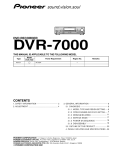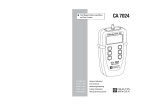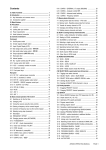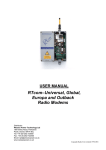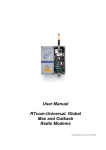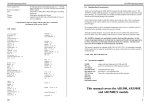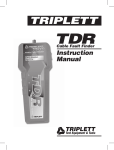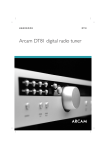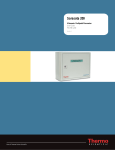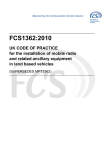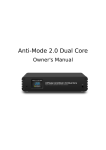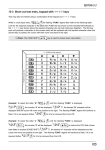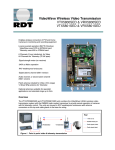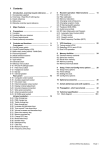Download AR3030 operating manual 1
Transcript
AR3030 operating manual (1) Introduction & accessories Thank you for purchasing the AOR AR3030 General Coverage Receiver. The AR3030 uses the very latest DDS (Direct Digital Synthesizer) technology to ensure the highest levels of design, performance and reliability. A TCXO (Temperature Compensated Crystal Oscillator) is provided for high stability and the legendary Collins 6kHz AM filter for the ultimate in AM selectivity. It is recommended that you carefully read this handbook and familiarise yourself with the receiver before placing it into operation. Every effort has been made to make this manual correct and up to date. Due to continuous development of the receiver and by error or omissions anomalies may be found and this is acknowledged. Most apparent faults are usually due to accidental misoperation of the receiver, carefully read all of the manual before deciding to return the receiver for repair. Although carefully designed, the receiver (like all receivers) suffers from a degree of internal noises known as spurii. They are a product of the receiver’s circuitry and do not represent a fault. This manual is protected by copyright AOR Ltd 1993. No information contained in this manual may be copied or transferred by any means without the prior written consent of AOR Ltd. AOR and the [AOR] logo are trade marks of AOR, Ltd. * Collins is a trade name of Rockwell International. The use of Collins and “Collins inside” has been authorised by Rockwell International. All other trade marks and names acknowledged. E&OE. © 1993 AOR Ltd. Operating manual Conventions Where text appears in [BOLD UPPERCASE] the keys are to be pressed exactly as shown. For example: [4] [9] [mtr] Means press the 4 key followed by the 9 key followed by the mtr key. Words contained in speech marks “PASS” refer to indications displayed on the Liquid Crystal Display. Where the mode of FM is referred to, this indicates NFM (Narrow FM). For clarity, the LCD diagrams for key sequences often have highlights "" above digits to signify they are flashing. These highlights do not actually appear on the LCD. 1-1 Accessories supplied Mains power supply Operating manual 1 AR3030 operating manual (2) Table of contents 1 1-1 Introduction... Accessories supplied... 1 1 2 Table of contents... 2 3 Major features... 4 4 4-1 4-2 4-3 4-4 Precautions... Location... Looking after your receiver... Power requirements.. Aerial (antenna) connection... 8 8 8 8 9 5 Controls and functions... Front panel On/Off power switch... Headphone socket... Mode keys and indicators... Liquid Crystal Display (LCD)... VFO key... SCAN key... MEMO key... BW - Bandwidth key... TONE key... PASS key... AGC - Automatic Gain Control key... ATT - Attenuator key... M.in - Memory input key... Numeric keypad 0 - 9... [.] decimal and separator key... [MHz] MHz key... [kHz] kHz key... [mtr] metre key... ENT/BS - Enter and Backspace key... Volume control... BFO pitch control... SQL - Squelch control.. RF gain control... Rotary tuning control... S-meter - (signal strength meter)... Loudspeaker (internal)... Rear panel EX power - external power connection... AUX socket... SP - Speaker output socket... FAX - FAX audio output socket... RS232C - Computer control port... GND - Ground connection... Wire ANT - (aerial) connector... ANT selection - Selection switch... WHIP ANT / 50 OHM / LW-HF ANT socket... 10 11 10 12 12 12 12 13 13 13 14 14 14 15 15 15 15 16 16 16 16 17 17 17 18 18 18 18 19 20 20 20 21 21 21 21 22 22 5-1 5-2 5-3 5-4 5-5 5-6 5-7 5-8 5-9 5-10 5-11 5-12 5-13 5-14 5-15 5-16 5-17 5-18 5-19 5-20 5-21 5-22 5-23 5-24 5-25 5-26 5-27 5-28 5-29 5-30 5-31 5-32 5-33 5-34 5-35 2 AR3030 operating manual 5-36 5-37 5-38 VHF ANT - VHF socket... LIGHT switch... BATT compartment... 22 22 22 6 6-1 6-2 6-3 6-4 6-5 6-6 6-7 6-8 6-9 6-10 6-11 6-12 6-13 6-14 6-15 6-16 6-17 6-18 6-19 6-20 Basic manual operation on the receiver... Tuning the receiver using the rotary control... Changing receive mode... Changing VFO A/B... Tone - Audio tailoring... Bandwidth and filters... AGC - Automatic Gain Control... ATT - Attenuator operation... RF gain control... Squelch control... BFO pitch control... VFO and keypad lock... Entering a frequency via the keypad... Memory mode... Memory write... Deleting memory contents... Memory channel scan... Program memory channel scan... Pass channel operation... Pause time programming in scan mode... Delay time programming in scan mode (VHF only)... 23 24 24 26 27 27 28 28 29 29 29 30 31 32 33 34 36 37 38 38 39 7 7-1 7-2 7-3 7-4 7-5 7-6 7-7 7-8 7-9 Computer control (RS232C)... 40 Connection... 40 Communication parameters... 41 Start up and end... 41 Command transmission in terminal mode... 41 Monitoring the contents of received serial data... 42 FORMAT 1 - Contents of the received signal... 42 FORMAT 2 - Reading the receiver’s signal strength... 43 FORMAT 3 - Transmitting the memory contents... 43 Change the receive modes or Make new entries... 43 8 Optional accessories... 45 9 Trouble shooting - (microprocessor reset)... 46 10 Aerials (antennas) and earth systems... 47 11 Propagation - shortwave bands... 51 12 Specification... 54 3 AR3030 operating manual (3) Major features General The AR3030 offers the very latest technology through use of its’ DDS (Direct Digital Synthesizer). The legendary Collins 6kHz AM filter is fitted as standard to provide the highest levels of AM selectivity. High stability is accomplished by the standard fitting of a TCXO (Temperature Compensated Crystal Oscillator). As the model name would suggest, the tunable coverage is 30kHz - 30 MHz (with 29.999995 MHz being the actual upper limit of tuning) using silky-smooth 5Hz steps. The AR3030 offers all mode operation as standard: AM, S.AM (double side band synchronous), USB, LSB, CW, FAX & FM. All necessary information relating to frequency, filter setting etc is presented via a highly visible switchable backlit custom LCD. Mode selection is displayed via a series of LEDs. Although 5Hz tuning steps are available in all modes coupled to true automatic carrier insertion in USB, LSB, FAX & CW, a separate BFO control is selectable in USB, LSB, FAX & CW to provide even greater flexibility producing a manual form of pass band tuning. While in any receive mode it is possible to increase the tuning steps from five Hz (display resolution 10Hz) to hundreds of Hz and kHz by pressing the kHz key while in VFO mode. Selection of MHz tuning may also be accomplished in VFO mode by pressing the MHz key. The position of the underscore character “_” indicates selected tuning rate. A smooth action rotary tuning control with a finger-tip-hollow is provided to ensure a high level of operating pleasure, convenience and versatility. Frequencies may be entered directly via the numeric keypad, great versatility is provided by careful attention to firmware programming. Frequencies may be entered as kHz i.e. [6] [0] [9] [0] [kHz], MHz i.e. [6] [.] [0] [9] [0] [MHz] or the “band” may be selected i.e. [4] [9] [mtr] returns to the last frequency used on that band, probably no other receiver offers such convenience. All broadcast bands are recognised as well as region 1,2 & 3 Amateur bands... i.e. 80, 75, 49m etc. Twin VFOs retain all necessary information such as frequency, mode, I.F. bandwidth, audio filter, attenuator setting and tuning step size and BFO status On/Off. 100 memories also hold the full range of settings making transfer to and from memory straight forward and very convenient. Optional VHF converters Two optional VHF converters are planned: 4 AM 108.00000 MHz to 139.99999 MHz FM 140.00000 MHz to 169.99999 MHz AR3030 operating manual One converter may be internally fitted to further extend the receive coverage of the receiver. A separate 50 OHM BNC aerial socket is fitted to the rear case of the AR3030 in order to simplify connection to a dedicated VHF aerial. SSB (Single Side-Band) - who uses it? SSB is a general term given to two additional modes of operation USB for upper-side-band and LSB for lower-side-band. Generally speaking, SSB is used by long range services such as oceanic airband, ship to shore and Amateur band to increase the operational coverage of the radio transceivers. Most point-to-point services use USB including Amateur band. By convention, Radio Amateurs use LSB below 10MHz. True carrier insertion is used for USB, LSB and CW with a separate SSB highly selective filter being used for these modes. A BFO control (which operates in CW, USB, LSB & FAX modes) has also been provided so that the CW note may be optimised to suit individual preferences and to form a simple manual form of passband tuning, particularly helpful on a crowded frequency. The inclusion of SSB on the AR3030 adds a new dimension to the listening potential of the receiver when compared to AM broadcast-only shortwave receivers. All Mode As well as SSB, the AR3030 can receive all other popular modes: AM (Amplitude Modulation) used mainly by broadcast stations and some other services (such as VHF commercial airband with the optional VHF converter fitted). Synchronous AM (double side band) used to combat fading on the shortwave bands. NFM (Narrow band Frequency Modulation) little used on the shortwave bands but found on the UK CB radio and 10m Amateur Bands. Bandwidth and filters The AR3030 is fitted with several standard IF bandwidths including a cascade 8kHz/-6dB ceramic filter (CFU455G2) for AM/SSB/FAX/CW plus two audio bandwidths: AM/S.AM 6kHz/-3dB in the normal position using the legendary Collins eight resonator mechanical filter (526 8636 010) and a 2.4kHz/-6dB Murata ceramic filter (CFJ455K6) in the narrow position. Should the narrow CW optional PCB position not be used, it is possible to fit an additional wider filter for AM such as Collins 8.5kHz/-3dB 526 8561 020. Due to the I.F. cascade filter, the widest possible filter is 8.5kHz. USB/LSB/FAX 2.4kHz Murata ceramic filter (CFJ455K6). An optional 2.5kHz/-3dB Collins eight resonator mechanical filter (526 8635 010) of higher specification may be 5 AR3030 operating manual optionally fitted (workshop fitting) to replace the 2.4kHz filter. Should the narrow CW optional PCB position not be used, it is possible to fit the optional Collins 2.5kHz filter as an addition which will be selected in the narrow position. CW 2.4kHz Murata ceramic filter in the Normal position. An optional 500Hz/-3dB Collins seven resonator mechanical filter (526 8634 010) may be optionally fitted (workshop fitting)in the Narrow position. FM 15kHz Murata ceramic filter (CFU455E2) fixed. Selection of Normal/Narrow is disabled. Attenuator, whip amplifier and aerial input & AGC The AR3030 does not contain RF amplification prior to the band-pass filters, all gain is applied in the more selective IF stages. This ensures the highest immunity to intermodulation effects often caused by the high number of strong signals encountered on the shortwave bands. There are two aerial inputs. The first is of the standard BNC type allowing straight forward connection to almost any low impedance shortwave dipole or multiband aerial system. The second is a “jaw” designed for a high impedance long wire. An earth connection is also provided on the rear panel. A rear panel three position slide switch selects the 50 OHM BNC connector or high impedance wire input. The third position applies a preamplifier and impedance matching network to the BNC aerial socket which may be used in conjunction with a telescopic whip aerial to enable a fair level of operation away from a long wire aerial or more elaborate system. An aerial attenuator system allows selection of 0db, 10dB or 20dB from the front panel. RF gain is also available via a front panel rotary control, this is especially useful in providing optimum audio quality for SSB operation. AGC attack / decay may also be selected from the front panel either fast or slow but cannot be switched off. Memories & SCAN There are 100 memory channels which can store frequency, mode, AGC, attenuator, bandwidth, AF filter (tone), BFO and lockout status. The memories may be used to store shortwave or VHF frequencies if the VHF converter option has been fitted. Program scan allows only a selected block of channels to be scanned while lockout permits certain channels to be skipped. Pause and delay scan add to flexibility. Data may be easily entered into memory and back to VFO where it may be tuned. 6 AR3030 operating manual There is a massive EEPROM store for all memory channels and VFO data so that no memory backup battery is required. The memories may be overwritten time and time again. RS232 computer port A 9 pin D type socket is fitted to the rear case, this will permitcontrol of many receiver facilities via a computer. Loudspeaker and audio output The AR3030 has a built-in 66mm 3 WATT loudspeaker. A 3.5mm jack socket is located on the rear panel of the receiver for external speaker connection. Connection to this socket automatically cancels audio from the internal speaker. Audio output is also available through a quarter inch headphone jack plug located on the front panel of the receiver. Use of this headphone socket automatically cancels output from both the internal and external loudspeaker if used. A low level audio output suitable for tape recording is available through via the AUX socket located on the rear panel. Switching to control a tape motor is also available via the AUX socket. A second constant level slightly higher output is available via a second rear panel 3.5mm socket suitable for connection to a facsimile decoder. AGC and IF outputs are also available via an 8 pin DIN socket located on the rear panel. Versatility & power connection The AR3030 can meet a number of requirements to satisfy Broadcast, Amateur band, Airband or Marine enthusiasts, Professional off air monitoring and of course casual listening too. The World’s shortwave and Amateur bands can be monitored, even the longer range Oceanic Airband and ship to shore. The receiver is designed to operate from either an external DC supply (such as that provided) of a nominal 13.8V DC or from internally fitted batteries (8 x AA dry cells which may not have been provided). Although rechargeable batteries may be used with the receiver, they must be externally recharged. The receiver must never be connected directly to the mains supply. (4) Precautions 7 AR3030 operating manual 4-1 Location Do not use or leave the receiver in direct sunlight. It is best to avoid locations where excessive heat, humidity, dust and vibration are expected. Always treat the receiver with care. Take care to avoid spillage or leakage of liquids into the receiver and AC power supply. Special care should be taken to avoid liquid entering via the power jack. Always remove batteries if the receiver is not going to be used for a while. Avoid static discharge from wire aerials, earth to a central heating radiator or similar in order to discharge the wire before connection to the AR3030. Always disconnect and earth an aerial system if an electrical storm is expected. Avoid connecting / disconnecting the power connection or batteries with the set switched on. Avoid a rapid switch On/Off sequence. If switched off, leave at least ten seconds before switching on again. Ensure the mains plug connections are tight and DC connections such as cigar lighters secure. Avoid strong RF fields from near by transmitters. If in doubt, disconnect the AR3030 from the aerial and switch the set off. 4-2 Looking after your receiver Always keep the receiver free from dust and water. Use a soft dry cloth to gently wipe the set clean. Never use chemicals such as benzine or thinners which will damage certain parts. 4-3 Power requirements The AR3030 is designed for operation from an external DC supply of 11 - 16V DC at approximately 0.7A minimum or from internal fitted dry batteries. Always use the mains power supply provided, or from a regulated DC power supply of 13.8V @ 0.7A or more using the optional DC3000 connecting lead. Always switch the receiver off when connecting or disconnecting the receiver. Note: The DC input socket uses a special type of connector. This plug/socket is of a moulded type and pre-wired, positive is the RED wire. The chassis of the receiver is negative ground. The UK power supply has two cables attached. One is terminated in the appropriate power jack plug to fit the DC input socket of the AR3030. The second has two bared wires ready for connection to a standard 3-pin mains plug. A 3 Ampere fuse should be used in the plug and the cable is colour coded as follows: Brown: Blue: 8 Live Neutral AR3030 operating manual The AR3030 power supply has no connection to the EARTH pin of the mains plug. However a separate earth point is provided on the rear panel of the AR3030 for connection to a water pipe, central heating system radiator or external earth rod. If fitting a separate external earth rod, consider the implications carefully is your mains supply uses Protective Multiple Earth (PME) system. If in doubt consult an expert electrician. Never earth to a gas pipe! Always disconnect the power supply from the AC mains supply when not in use. Always remove dry batteries when exhausted or if the AR3030 is not going to be used for a while. This will avoid leakage which could seriously damage the receiver. Access to the battery compartment is via a removable sub-panel on the rear panel. Always switch the receiver off when inserting or removing batteries. If fitting batteries always select a quality brand, 8 x AA size 1.2 or 1.5V cells are required. 4-4 Aerial (antenna) connection The low impedance aerial input is of a high quality BNC type as preferred by commercial users rather than the cheaper SO239 type. Adaptors are readily available to convert from a BNC to almost any other plug or socket as required allowing straight forward connection to almost any shortwave aerial. The second input is a “jaw” designed for a high impedance long wire. An earth connection is also provided on the rear panel. A rear panel three position slide switch selects the 50 OHM BNC connector or high impedance wire input. The third position applies a preamplifier and impedance matching network to the BNC aerial socket which may be used in conjunction with a telescopic whip aerial to enable a level of operation away from a long wire aerial or more elaborate system. The AR3030 does not contain RF amplification prior to the band-pass filters, all gain is applied in the more selective IF stages. This ensures the highest immunity to intermodulation effects often caused by the high number of strong signals encountered on the shortwave bands. An aerial attenuator system allows selection of 0db, 10dB or 20dB from the front panel. RF gain is also available via a front panel rotary control, this is especially useful in providing optimum audio quality for SSB operation. AGC attack / decay may also be selected from the front panel either fast or slow but cannot be switched off. Aerial Tuning Units (ATU) 9 AR3030 operating manual An ATU can improve the selectivity of any shortwave receiver when connected to long wire aerial other than a short wire of a few metres. This valuable extra selectivity is created provided by the ATU rejecting out of band signals enabling the receiver to “single out” one band of frequencies while rejecting potentially strong unwanted transmissions. An ATU is usually constructed in a small box with about two or three controls on the front panel. One disadvantage however is the need to constantly retune the ATU when changing frequency. An ATU of this type has no active circuitry so is known as a passive device. Active desk-top loop aerials Usually designed for the shortwave bands (such as the AOR LA320. Loop aerials have the advantage of small size when compared to long wire aerials and being within easy reach of the operator it can be rotated to provide directivity. The circuitry offers a small level of gain with the advantage of selectivity similar to an ATU. * For further information please refer to section 10 of this manual regarding aerial and earth systems. (5) Controls and functions The AR3030 receiver is housed in a strong metal cabinet. Controls for operation are located on the top and front of the cabinet with connections to the rear. Front panel 5-1 On/Off power switch This square shaped black plastic button switches the set O/Off when running from an external power supply or internal batteries. To switch the set On, connect a suitable power source and depress the switch, it will latch in. To switch the receiver Off press the switch a second time, the switch will latch out. 5-2 Headphone socket 10 AR3030 operating manual 11 AR3030 operating manual This quarter inch socket is located on the top left hand side of the front cabinet directly underneath the power switch. A pair of headphones or earphone may be connected with an impedance of 8 OHMS or greater. When this headphone socket is used, the internal speaker and any external speaker will be automatically disconnected. 5-3 Mode keys and indicators There are two mode keys on the front panel located between the S-meter and LCD, there are also seven LED indicators to show current mode selected. Either key may be pressed to select mode. 5-4. Liquid Crystal Display (LCD) Display of most data (excluding mode which is displayed via LEDs) is provided via a high contrast wide angle backlit green LCD. A rear panel switch is provided so that the illumination may be switched Off to help preserve battery power should the set not be powered via the external power connection. 5-5 VFO key “VFO” is not really the correct name but rather a historical title for current tuning device, it stands for Variable Frequency Oscillator. As the AR3030 uses DDS no variable frequency oscillator is actually used in this up-to-date receiver but the term is generally understood as meaning current setting of a rotary dial. The AR3030 has two VFOs’ (two selectable tuners) so that the user may quickly swap between and tune around two frequency bands with a single press of the VFO key. VFO status is indicated by “[A]” or “[B]” on the LCD. If the word “[MEMO]” is 12 AR3030 operating manual displayed on the LCD, press [VFO] to select tuning manual tuning. 5-6 SCAN key The SCAN key is used to start the memory scan facility which will cause the receiver to check the occupied channels of it’s memory content for activity (busy channels). SCAN can only be selected if the AR3030 is in VFO mode. It is possible to select all memory channels to be scanned or just a specified range of memory channels. It is also possible to “lock out” unwanted channels so they will be skipped during memory scan. The [SCAN] key is also used in programming of SCAN DELAY. 5-7 MEMO key The MEMO key the receiver into MEMORY mode so that a previously stored frequency can be monitored. Pressing [MEMO] twice first calls up the current memory channel then writes the contents to the currently selected VFO so it may be tuned. The [MEMO] key is also used in the programming of SCAN DELAY. 5-8 BW - BandWidth key The BW key allows selection of filter bandwidth as indicated by the “[NOR]” (normal) and “[NRW]” (narrow) indicators on the LCD. The AR3030 is fitted with several standard IF bandwidths. AM/S.AM 6kHz/-3dB in the normal position using the legendary Collins eight resonator mechanical filter and a 2.4kHz/-6dB Murata ceramic filter in the narrow position. Should the narrow CW optional PCB position not be used, it is possible to fit an additional wider filter for AM. USB/LSB/FAX 2.4kHz Murata ceramic filter. An optional 2.5kHz/-3dB Collins eight resonator mechanical filter of higher specification may be optionally fitted to replace the 2.4kHz filter. Should the narrow CW optional PCB position not be used, it is possible to fit the optional Collins 2.5kHz filter as an addition which will be selected in the narrow position. CW 2.4kHz Murata ceramic filter in the Normal position. An optional 500Hz/-3dB 13 AR3030 operating manual Collins seven resonator mechanical filter may be optionally fitted in the Narrow position. FM 15kHz Murata ceramic filter fixed. Selection of Normal/Narrow is disabled. 5-9 TONE key Audio quality may be tailored to suite the type of listening. When a transmission is noisy or suffering from interference, it may be useful to change the audio tailoring to improve readability by making reception more or less “toppy”. Status of TONE setting is displayed by “[HIGH]” and “[LOW]” indications on the LCD. USB/LSB/AM/S.AM/FM HIGH position cut off frequency 3000 Hz LOW position cut off frequency 1800 Hz CW TONE key inoperative. Frequency set to 800 Hz. FAX TONE key inoperative. 5-10 PASS key The PASS key is used in MEMORY mode to lockout (PASS) unwanted channels during memory scan. Pressing the [PASS] key a second time will reinstate a locked out channel. Status of memory channel pass is indicated by “PASS” on the LCD. This key is also used in the programming of MEMORY DELETE. 5-11 AGC - Automatic Gain Control key The AGC key is used to select the Automatic Gain Control setting on all modes except FM. The status of AGC is indicated on the LCD by “[FAST]” and “[SLOW]” on the LCD. It is not possible to switch the AGC off. Generally speaking “[FAST]” is used for CW and some data communications reception and “[SLOW]” is used for USB & LSB. A slow setting in SSB modes can reduce the background noise during pauses in speech. For AM and S.AM reception the setting will depend on reception conditions for best setting. 5-12 ATT - attenuator key 14 AR3030 operating manual The attenuator facility can be useful for reducing the level of unwanted strong signals or “overload”. The AR3030 has three settings of attenuator (ATT), these being 0dB (no indication on the LCD - normal setting), -10dB “[10dB]” indicated and -20dB “[20dB]” indicated. The AR3030 does not contain RF amplification prior to the band-pass filters, all gain is applied in the more selective IF stages. This ensures the highest immunity to intermodulation effects sometimes caused by a large number of strong signals encountered on the shortwave bands. The [ATT] key is also used in the programming of PROGRAM MEMORY CHANNEL SCAN. 5-13 M.in - Memory input key The [M.in] key is used to enter frequencies from the currently selected VFO into memory. When [M.in] is pressed a flashing two digit memory channel number indicates memory input selection in progress. To abort memory input without executing simply press [M.in] a second time or press [MEMO] or [SCAN]. The [M.in] key is also used in the programming of MEMORY DELETE. 5-14 Numeric keypad - 0 to 9 keys The numeric keypad is located on the front panel underneath and to the right of the Liquid Crystal Display (LCD). The keypad is laid out in a logical manner and is split into numeric and command areas. The numeric keys are used for entering a frequency, memory channel, memory lockout, memory delete and other functions. 5-15 [.] decimal and separator key Press the [.] key once to act as a decimal point separator when entering frequency in MHz i.e. while in VFO mode [1] [4] [.] [1] [MHz] (MHz frequency entry) This key is also used as a separator when programming memory scan limits and memory delete limits. 5-16 [MHz] MHz key 15 AR3030 operating manual The [MHz] key is used to complete frequency entry when MHz selection is required i.e. while in VFO mode [4] [.] [7] [2] [2] [MHz] While in VFO mode, this key alters selection of tuning rate to MHz. An underscore “[ _ ]” indicates the selection of MHz tuning speed on the LCD. Note: Frequencies below 1.8 MHz are treated as kHz. For this reason 1 MHz cannot be selected using the [MHz] key in conjunction with the rotary tuning control. 5-17 [kHz] kHz key The [kHz] key is used to complete frequency entry when kHz selection is required 1.e. while in VFO mode [4] [7] [2] [2] [kHz] While in VFO mode, this key alters selection of tuning rate from 5Hz (10Hz indication) to hundreds of Hz and kHz. An underscore “[ _ ]” indicates the current tuning speed on the LCD. While using the VHF converter, frequency step size range is 5Hz, 10Hz, 100Hz, 1kHz, 100kHz. When tuning in 5Hz steps, a square box appears to the right hand side of the LCD. 5-18 [mtr] metre key The [mtr] key is used to complete frequency band entry. i.e. while in VFO mode, to call the 49m broadcast band type [4] [9] [mtr] Pressing [0] [mtr] while in VFO mode selects manual BFO tuning for CW and SSB modes. An “[o]” indicator appears on the LCD to confirm selection. The same sequence de-selects manual BFO. 5-19 ENT/BS - ENTer and BackSpace key This key is not used for frequency entry but to complete sequences of various data such as memory scan and delete. During keypad frequency entry this key may be used to backspace delete incorrect entries. If you wish to abort the completed keypad frequency entry press [MEMO] to return to VFO mode. While in VFO mode, pressing the [ENT/BS] key activates keypad and rotary tuning lock. A row of five underscores “[_ _ _ _ _]” indicates keypad / VFO lock. Press the key a second time to deactivate keypad lock. 16 AR3030 operating manual The receiver will always deactivate keypad/VFO lock when switched Off/On. 5-20 Volume control The volume control is located on the front panel underneath the mode switches. It is used to to set the required audio output through the loudspeaker or headphone. When turned fully clockwise the volume is at maximum, when rotated fully anti-clockwise the volume is reduced to minimum. 5-21 BFO PITCH control This control is active only when the “[o]” indicator is displayed on the LCD. The BFO (Beat Frequency Oscillator) allows manual reinsertion of carrier in CW, USB, LSB and FAX modes. This forms a manual passband tuning mechanism useful to remove unwanted interference. To activate while in VFO mode, press [0] [mtr]. The same sequence deactivates the BFO circuit. In the default position (BFO Off - no “[o]” indicated), carrier reinsertion is automatic making tuning easy and resolving SSB pleasurable. 5-22 SQL - squelch control The squelch control is a smaller rotary control located on the front panel underneath the volume control. This control is used to eliminate unwanted background noise when monitoring a normally inactive frequency such as 5.680MHz international search & rescue or when memory SCAN is required. The squelch is not usually used when listening to shortwave transmissions due to the relatively high background noise levels. The usual setting for the control is fully anti-clockwise. The squelch setting is by the receiver’s microprocessor to decide when to stop during memory scan. The squelch opening / closing also controls the tape recorder switching circuitry so a small internal “click” may be heard when the squelch activates. The squelch control requires careful setting to achieve optimum operating performance. Rotate the control clockwise until the background noise just disappears (threshold), this is the most sensitive setting of the control. In practice the control is usually rotated a little further clockwise beyond the threshold point to prevent the receiver from stopping on noise or very weak and unreadable signals. 17 AR3030 operating manual If the control is rotated too far clockwise then weaker signals will be totally lost and only local strong signals will be heard. 5-23 RF GAIN control This small rotary tuning control is located on the front panel underneath the BFO PITCH control. The RF GAIN control reduces the level of amplification applied to the receiver’s I.F. circuits. This has the effect of reducing the sensitivity of the receiver in much the same way as the attenuator but is more controllable. The usual position for the RF GAIN control is fully clockwise when the set is at its most sensitive. As the control is rotated anti-clockwise the S-meter will advance to indicate what strength signal is required to produce solid and readable results. The control is most useful on SSB where the RF GAIN should be adjusted so that the “peaks” of SSB signals just deflect the S-meter. This will greatly reduce the level of background noise especially during pauses in speech or inactivity. 5-24 Rotary tuning control The large rotary tuning control is prominently located on the front of the cabinet. This control changes the received frequency up and down in whatever step increment is selected by the [kHz] and [MHz] keys. The minimum tuning rate is 5 Hz. This control is often referred to as the “VFO”. 5-25 S-meter (signal strength meter) The rear illuminated analogue SIGNAL METER is located to the left hand side of the front panel. Relative strength of incoming signal is indicated in standard “S” points where S1 is weak and S9 is strong. Calibration above S9 is in dB. As with other receivers, the calibration may not be reliable on FM mode. 5-26 Loudspeaker (internal) The AR3030 is fitted with a large 66mm 3 WATT internal loudspeaker. Due to clever design, sound is projected through a small front mounted speaker grille. When an external speaker or headphone is connected, the internal speaker is automatically disconnected. Rear panel 5-27 EX POWER - external power connection 18 AR3030 operating manual 19 AR3030 operating manual This is a special switching three pin socket designed to accept external DC input of a nominal 13.8V DC @ 0.7A negative ground. You may either connect the power supply provided or another suitable supply such as a 12V car battery using the optional DC3000 DC lead and observing the correct polarity: RED = positive WHITE = negative At no time must AC mains power be connected directly to this socket or serious damage may occur and a risk of personal injury. When the power plug is removed from the EX POWER socket, supply is automatically switched to internal batteries should they be fitted. 5-28 AUX socket This 8 pin DIN socket provides various control facilities for connection to external peripherals such as tape recorders. The pin connections are as follows: 1 AGC output approximate level 0 to +3V. Do not ground. 2 Ground 3 External RF gain. 0 to +1.5V. This connection may be used as transmit mute by applying +1.5V to this point during transmit. Should you wish to monitor your own transmit audio reduce the voltage toward 0V to find an acceptable level. 4 I.F. output. Frequency 455kHz, level between 30 to -20 dBm / 50 OHM. 5 Record audio output, level -20dBm (77mV) / 600 OHM. 6 Tape switch relay controlled. Normally open with squelch closed. 7 Tape switch relay controlled. Normally open with squelch closed. 8 Ground. 5-29 SP - Speaker output socket This 3.5mm mono jack socket provides audio output to drive an external speaker unit. Connection to this socket automatically disables the internal speaker but not a headphone if connected to the front panel socket. 20 AR3030 operating manual An external speaker should have a nominal 8 OHM impedance and power handling of 2 WATTS or greater. 5-30 FAX - FAX audio output socket This 3.5mm mono jack socket is designed to provide a suitable audio characteristic and constant level output to feed data facsimile decoders. Output is 600 OHM 0dBm constant. 5-31 RS232C - Computer control port The 9 pin female D type RS232C control socket and associated internal circuitry is fitted as standard. This permits the receiver to be connected directly to a computer for “hands off” remote control. Please refer to the COMPUTER CONTROL section (7) for a full list of facilities, protocols and connection details. 5-32 GND - Ground connection This “jaw” is designed to accept an external earth connection (such as a separate earth rod or connection to a central heating radiator etc). To operate, lift up the plastic tag, place the conductor into the connection hole and press firmly closed using a downward motion. Connection to a good external RF earth will enhance the receiver’s performance and reduce interfering electrical noise. Should your building use PME (Protective Multiple Earthing) ensure the electrical wiring is well bonded. If in doubt, consult a qualified electrician. 5-33 WIRE ANT - Wire (aerial) connector This aerial input “jaw” is designed to accept the conductor of a random length wire aerial. To operate, lift up the plastic tag, place the conductor into the connection hole and press firmly closed using a downward motion. The input impedance is a nominal 450 OHMS. The aerial input is selected by the ANT SELECTION switch which should be placed into the left hand WIRE ANT position. 5-34 ANT SELECTION Selection switch 21 AR3030 operating manual This three position slide switch allows selection of aerial input. In the left position the high impedance wire input is selected. In the centre position a small level of amplification along with impedance matching is applied to the BNC aerial input to permit operation from a small high impedance telescopic whip aerial. In the right position the 50 OHM BNC aerial socket is selected allowing connection to low impedance coaxial aerials such as dipoles, magnetic baluns, loop aerials (AOR LA320), coaxial fed systems (like the AOR WA7000 active aerial) or an aerial tuning unit. 5-35 WHIP ANT / 50 OHM / LW-HF ANT socket This is a high quality 50 OHM BNC aerial input socket. BNC is the commercial standard and offers superior performance to the cheaper SO239 socket. Of course inter-series adaptors are widely available so connection to almost any aerial system should not present a problem. 5-36 VHF ANT - VHF socket This is a 50 OHM BNC aerial input socket for use when an optional VHF converter is fitted. Suitable aerials include telescopic whips, VHF dipoles, groundplanes and discones. 5-37 LIGHT switch The LCD and S-meter illumination is selectable On/Off via this switch. This facility is particularly useful if the receiver is being operated from batteries in order to reduce the current taken by the receiver and lengthen the operational time. 5-38 BATT compartment This is the battery compartment. Access is achieved by removing (and carefully storing) the two knurled nuts. Inside the battery compartment is a cradle designed to accept 8 x UM-3 (AA size) batteries. The receiver has not been designed to operate for a long time from batteries. However, depending upon the type of battery used operation is typically 30 minutes using Manganese and 45+ minutes when using Alkaline cells. Always remove the batteries when they have expired (run down). Should you plan not to use the receiver for a period of time, remove the batteries to avoid potential leakage. Note: The memory channel data is held by an internal EEPROM which does not require batteries or connection to external supply. 22 AR3030 operating manual (6) Basic manual operation of the receiver Connect and select an appropriate aerial (antenna) to the input on the rear of the receiver. The selection of aerial depends upon your location and specific requirements but may include a dipole or long wire. There is further aerial information in this manual (section 10). If in doubt please consult your dealer. Connect the AR3030 to an appropriate DC power source using either the supplied AC adaptor or optional DC3000 DC lead. Never connect the receiver directly to the mains. Before turning on the power switch, set the volume to the 10 o’clock position and squelch control to the 8 o’clock position (fully anti-clockwise). Press the power switch until it latches in (depressed) which is the “On position”. Ensure the label “MEMO” is not displayed on the LCD, if it is then press the [VFO] key once until the label “MEMO” is cancelled. When the above procedure is complete the receiver is ready to accept frequency input, change of mode etc. As with all modern microprocessor controlled equipment, the AR3030 has enormous potential and capabilities. Note: The AR3030 uses an EEPROM (Electronically Erasable Programmable Read Only Memory) for storage of memories, metre band information and other parameters. A permanent storage EEPROM has the advantage of not requiring a back-up battery to maintain data even when the receiver is disconnected from a power supply. The EEPROM may be over-written many thousands of times. In order to provide the maximum EEPROM life span a “fuzzy logic” has been applied to the storage system which attempts to intuitively determine when to store new data. For this reason, the last frequency used in VFO mode via the tuning control or keypad will not be recalled upon switch-On unless you had listened to it for more than about 15 seconds (the actual time depends upon many factors but typically ranges from 6 to 13 seconds). Similarly when using the metre key, if you haven’t “listened” to a new frequency for more than 15 seconds or so, it will not have updated the metre band data. This can be used as a positive asset under certain circumstances when tuning through amateur radio bands etc and you wish to return to the starting point... simply re-enter the metre band. To achieve the maximum use of the receiver’s performance and features, it is important to fully familiarise yourself with it’s operation through the use of this handbook. 6-1 Tuning the receiver using the rotary control 23 AR3030 operating manual The receiver may be immediately tuned via the rotary tuning control. The free running tuning knob is used to select receiving frequency and in memory mode for selection of memory channel. The tuning knob is by far the most “traditional” approach to tuning on shortwave providing a smooth feel and the best method of user interface especially when listening on the SSB, FAX and CW modes. It is possible to tune the receiver through it’s entire range from 30kHz to 29.99999MHz. Rotating the tuning control clockwise increases the displayed frequency (and tunes the receiver upward), rotating the tuning control anticlockwise decreases the displayed frequency (and tunes the receiver downward). At some point you may wish to increase the speed of tuning, this is accomplished using the [kHz] and [MHz] keys. You will note a small underscore “_” underneath one of the frequency readout digits. It is possible to move the underscore by pressing the [kHz] key. The underscore will move from the underneath of the right digit (tens of Hz), second from right (hundreds of Hz) and third from right (kHz). Pressing the [kHz] key again returns the underscore to the right. The position of the underscore determines the rate of tuning. On shortwave, the receiver will tune in either 5Hz steps (10Hz resolution), 100Hz steps of 1kHz steps. In a similar way, you may decide to change the MHz readout using the rotary tuning control. To accomplish this, simply press the [MHz] key. An underscore “_” will appear on the LCD underneath the MHz digit to confirm selection. To return to fine tuning press the [kHz] key. 6-2 Changing receive mode There are two mode keys on the front panel located between the S-meter and LCD, there are also seven LED indicators to show the current mode selected. Either key may be pressed to change mode. Any receive mode may be selected at any frequency within the receiver’s shortwave coverage. Generally speaking the following modes will apply: AM Amplitude Modulation - Used by broadcast services throughout the World on longwave, medium wave and shortwave. AM is also used by commercial airband 108 - 137MHz (should you have the VHF converter option fitted). For best results, you will have to experiment with the setting of AGC between fast and slow. S.AM Synchronous AM - (the AR3030 uses double side band synchronous 24 AR3030 operating manual detection). This is a special form of AM reception capable of reducing fading on longwave, mediumwave and shortwave signals especially at night. The receiver must first be accurately tuned in standard AM mode then switched to S.AM. A short whistle may be heard as the set “locks” onto the received station. If a sustained whistle is encountered then you probably do not have the receiver quite centred on the station, try tuning up and down by a couple of kHz and try again. For best results, you will have to experiment with the setting of AGC between fast and slow. FM Narrow Band Frequency Modulation - this provides high quality communication for relatively short distance operation. FM uses a greater frequency bandwidth than other modes such as SSB so is less efficient. Typically on shortwave, FM is used by UK Citizen Band radio and 10m Amateur Band operation centred around 29.6 MHz. FM is widely used on the VHF bands: Marine band, 2m Amateur Band (145MHz) and PMR (Private Mobile Radio) but not commercial airband which still uses AM. If the optional VHF converter fitted, FM will be quite active in most areas. In the absence of a signal, the background white noise may appear quite loud. For ease of listening the squelch control should be rotated clockwise until the background noise just disappears, this should be carried out when no signal is present. The point where the background noise is cancelled is known as “threshold point”. Do not advance the squelch control more than necessary or the receiver will appear to be desensitised and weaker signals will be missed. LSB Lower Side Band - is a form or Single Side Band (SSB). LSB tends not to be used commercially but is extensively used by Radio Amateurs on frequencies below 10 MHz. This assists the separation of Commercial and Amateur users on traditionally shared bands and prevents them from speaking to each other. SSB is a very efficient method of transmission as the unwanted second sideband and carrier have been removed. This allows the full transmitter power to be employed in carrying useful information within the wanted sideband. As a result greater distances are possible on SSB and a smaller frequency bandwidth is required than most other modes. The AR3030 uses true carrier re-insertion so that voice becomes intelligible. However due to the complexities of SSB, audio never sounds 100% natural and often listeners comment on it sounding a little like “Donald Duck” or “Micky Mouse” but this is normal and with practice you soon become used to this characteristic. The setting of AGC is important for SSB reception. Usually a SLOW setting provides the best results when background noise will usually be reduced. Rotate the RF gain control anti-clockwise so that the S-meter needle just “lifts” with voice peaks, this can reduce the background noise especially during 25 AR3030 operating manual pauses in speech. Do remember that reducing the RF GAIN control (which increases deflection of the S-meter) reduces the sensitivity of the receiver, the normal position is fully clockwise. USB Upper Side Band - The same comments apply as for LSB. By convention, Radio Amateurs also use USB above 10MHz. An optional Collins 2.5kHz 8 resonator mechanical filter of high specification may be fitted in place of the standard 2.4kHz Murata ceramic filter for improved selectivity. CW Continuous Wave - Often referred to a Carrier Wave or Morse code. Selection of CW changes the audio tailoring to best suite reception of “dots and dashes”. A 500Hz Collins 7 resonator mechanical filter may be optionally fitted in the NARROW filter position and will greatly aid rejection of unwanted signals on this mode. FAX Facsimile - Selection of [FAX] optimises the receiver for reception of weather and news facsimile. The 2.4kHz standard SSB filter is employed but audio tailoring is optimised for facsimile reception. A constant level 0dBm 600 OHM audio output is available through a rear panel 3.5mm FAX OUTPUT socket ready to feed an external facsimile decoder / printer such as the AOR WX-2000. 6-3 Changing VFO A/B In the true sense of the word, “VFO” stands for Variable Frequency Oscillator. Of course as technology improved so modern receivers do not strictly use a VFO, in the case of the AR3030 a Direct Digital Synthesizer (DDS) is employed. However, the term “VFO” has generally come to mean “current tuning parameters” and refers to the tunable frequency currently displayed along with mode and other settings such as attenuator, filters etc. In this sense, the AR3030 has two VFOs’ available A and B. Two VFOs’ can be useful for listening to split frequency communications such as a DX pile up on the Amateur bands where a much sort after station is transmitting on one frequency but listening on another. Another example would be coastal marine communications where split frequencies are employed. Should the optional VHF converter be fitted then split frequency operation (known as DUPLEX) is common place. (Single frequency operation is known as SIMPLEX). The currently selected VFO is indicated on the LCD by [A] or [B]. To change from one to another simply press the [VFO] key. To return to the original VFO 26 AR3030 operating manual press the [VFO] key again. Note: The rotary tuning control is also often historically referred to as the VFO. 6-4 TONE - Audio tailoring The audio characteristic is adjustable on most modes via the [TONE] key on the front panel. Selecting a high tone setting may improve the listening quality of strong broadcast services such as longwave but where adjacent interference is experienced selecting the low setting may reduce the levels of annoying heterodynes. The current setting of tone is indicated on the LCD as [HIGH] or [LOW]. The actual audio tailoring characteristics are: USB/LSB/AM/S.AM/FM TONE High position cut off frequency 3000 Hz TONE Low position cut off frequency 1800 Hz CW TONE key inoperative. Frequency set to 800 Hz FAX TONE key inoperative 6-5 Bandwidth and filters The AR3030 is fitted with several standard IF bandwidths including a cascade 8kHz/6dB ceramic filter (CFU455G2) for AM/ SSB/FAX/CW plus two audio bandwidths: AM/S.AM 6kHz/-3dB in the normal position using the legendary Collins eight resonator mechanical filter (526 8636 010) and a 2.4kHz/-6dB Murata ceramic filter (CFJ455K6) in the narrow position. Should the narrow CW optional PCB position not be used, it is possible to fit an additional wider filter for AM such as Collins 8.5kHz/-3dB 526 8561 020. Due to the I.F. cascade filter, the widest possible filter is 8.5kHz. USB/LSB/FAX 2.4kHz Murata ceramic filter (CFJ455K6). 27 AR3030 operating manual An optional 2.5kHz/-3dB Collins eight resonator mechanical filter (526 8635 010) of higher specification may be optionally fitted (workshop fitting) to replace the 2.4kHz filter. Should the narrow CW optional PCB position not be used, it is possible to fit the optional Collins 2.5kHz filter as an addition which will be selected in the narrow position. CW 2.4kHz Murata ceramic filter in the Normal position. An optional 500Hz/-3dB Collins seven resonator mechanical filter (526 8634 010) may be optionally fitted (workshop fitting)in the Narrow position. FM 15kHz Murata ceramic filter (CFU455E2) fixed. Selection of Normal/Narrow is disabled. The AR3030 is fitted with several standard I.F. bandwidths: Selecting a narrow filter setting can improve intelligibility under some circumstances when listening to AM and S.AM. The fitting of a narrow 500Hz CW filter greatly improves the rejection of unwanted adjacent signals. Indication of current setting is provide on the LCD as [NOR] or [NRW]. 6-6 AGC - Automatic Gain Control This key is used to select the Automatic Gain Control setting on all modes except FM. The status of AGC is indicated on the LCD as [FAST] or [SLOW]. It is not possible to switch the AGC off. Generally speaking [FAST] is used for CW and some data communications reception and [SLOW] is used for USB & LSB. A slow setting on SSB can reduce the background noise during pauses in speech. For AM and S.AM reception the setting will depend on receiving conditions. 6-7 ATT - Attenuator operation The attenuator can be useful for reducing the level of unwanted strong signals or overload. The AR3030 has three settings for ATT, these being 0dB (no indication on the LCD - normal setting), -10dB [10dB] indicated and -20dB [20dB] indicated. The AR3030 does not contain RF amplification prior to the band-pass filters, all gain is applied in the more selective I.F. stages. This ensures the highest immunity to intermodulation effects sometimes caused by a large number of strong signals on the shortwave bands. 6-8 RF GAIN control 28 AR3030 operating manual The usual position for this control is fully clockwise. The setting of RF GAIN is particularly important for SSB reception to prevent an unpleasant rise in background noise especially during pauses in speech. When listening to SSB transmissions, rotate the RF gain control anticlockwise so that the S-meter needle just “lifts” with speech peaks. This will greatly reduce background noise levels. Do remember that reducing the RF GAIN control (which increases deflection of the S-meter) reduces the sensitivity of the receiver, the normal position is fully clockwise. 6-9 SQUELCH control In the absence of a signal, background white noise may appear quite loud especially in FM mode. For ease of listening the AR3030 is fitted with an “all mode” squelch circuit. The squelch control should be rotated clockwise until the background noise just disappears and be carried out when no signal is present. The point where the background noise is cancelled is known as “threshold point”. Do not advance the squelch control more than necessary or the receiver will appear desensitised and weaker signals will be missed. It is important for the squelch control to close when using an optional VHF converter as it’s status is used by the microprocessor to determine when a frequency is clear and when it is busy. The usual position for the squelch control is fully anti-clockwise. 6-10 BFO PITCH control Due to the complexities of SSB, audio never sounds 100% natural and often listeners comment on it sounding a little like “Donald Duck” or “Micky Mouse”, this is normal and with practice you soon become used to this characteristic. The AR3030 uses automatic carrier re-insertion to make tuning of SSB/FAX/ CW as easy as possible. However should you wish to change the beat note on CW reception or alter the tonal characteristics of SSB/FAX it is possible to engage a manual BFO. “BFO” stands for Beat Frequency Oscillator and takes the place of automatic carrier re-insertion. One benefit of the manual BFO setting is to form a simple manual type of passband tuning to reduce the potential interfering effects of adjacent strong signals. The normal position for the BFO PITCH control is 12 o’clock. To activate the BFO in VFO mode press the [0] key followed by [mtr]. The LCD will display a “o” to indicate that manual BFO mode has been selected. If 29 AR3030 operating manual the BFO PITCH control is rotated it will initially sound like a fine tuning control. To practice using the BFO find an SSB transmission suffering from adjacent channel interference and tune away by a few kHz using the main rotary tuning control. Ensure the BFO PITCH control is selected and rotate the BFO PITCH control from side-toside until the signal becomes readable again. You should experience a reduction or elimination in adjacent channel interference in many cases. To return to automatic carrier reinsertion repeat the key strokes [0] [mtr] while in VFO mode. 6-11 VFO and keypad lock At times you may wish to lock the receiver onto a specific frequency or prevent accidental changing of data through the keypad. For this reason a “dial lock” facility has been provided. To activate dial lock while in VFO mode simply press the [ENT/BS] key. A row of underscores “_ _ _ _ _” will appear underneath all the LCD frequency display segments to confirm dial lock is on. To deactivate dial lock simply press [ENT/BS] again. The row of underscore characters will be removed from the LCD. Regardless of the dial lock selection, if switched Off/On, the AR3030 will always power up with dial lock off. 30 AR3030 operating manual 6-12 Entering a frequency via the keypad Where exact frequencies are known, you may wish to enter a frequency directly through the keypad. The numeric keypad is located on the front panel underneath and to the right of the LCD. The keypad is laid out in a logical manner and is split into numeric and command areas. The numeric keys are used for entering a frequency with the decimal key [.] acting as a separator. It is possible to enter frequencies as MHz, kHz or by metre band. Entry as MHz: For example, to select 14.10000 MHz follow the key sequence: [1] [4] [.] [1] [MHz] (MHz frequency entry) You will note that the trailing zeros are not required as the AR3030 completes the entry at the time the [MHz] key is pressed. Entry as kHz: For example, to select 4722 kHz (4.722 MHz) follow the key sequence: [4] [7] [2] [2] [kHz] (kHz frequency entry) Entry as mtr: Should you wish to start listening to a Broadcast or Amateur band but not a specific frequency, the [mtr] key provides immediate access with minimal key presses. The information will update as you recall [mtr] band and tune the receiver. At default the following [mtr] key defaults apply: Attenuator is always OFF VFO is always [A] Filter is always [NORM] AGC is always [SLOW]. With the frequency, mode and step size defaults: Correcting frequency input errors via the keypad Should you make a mistake when entering a frequency via the keypad there are two methods of correction. 31 AR3030 operating manual Back Space delete The [ENT/BS] key acts as a “BS” Back Space just like a computer keyboard deleting data input from the right hand side. For example, if you wish to enter 3.750 MHz but had keyed [3] [.] [7] [5] [8] the last digit being “8” in place of “0”, before pressing [MHz] press the [ENT/ BS] key. The last digit on the right hand side will be deleted. You can then press the correct key [0] and complete the sequence with [MHz]. Should you press [ENT/BS] twice during the sequence, then the first two digits on the right hand side would be deleted and so on. [MEMO] - abort frequency input Should you decide to abort the frequency input during programming, press the [MEMO] key once to abort. The display will return to the frequency prior to input and the sequence aborted. 6-13 Memory mode - [MEMO] - [M.in] - [PASS] - [ENT/BS] There are 100 memory channels (00 to 99) which can store frequency, mode, AGC, attenuator, bandwidth, AF filter (tone), BFO status and lockout status. The memories can be used to store shortwave or VHF frequencies if the VHF converter option has been fitted. Program scan allows only a selected block of channels to be scanned while lockout causes certain channels to be skipped. Pause and delay scan add to flexibility. Data may be easily entered into memory or from memory to VFO for tuning. There is a massive EEPROM store for all memory channels and VFO data so that no memory backup battery is required. The memories may be over-written time and time again. Note: Memory channels 1 to 9 must be entered using a zero prefix. i.e. memory channel 2 is “02” and channel 3 is “03” etc. Memory select - [MEMO] key In VFO mode the LCD display will not show any legend relating to the memory operations such as memory channel number, SCAN and PASS. To select memory mode press the [MEMO] key. The legend “MEMO” will appear on the LCD to confirm selection. 32 AR3030 operating manual Presuming data has been stored, in memory mode press [0][1] to select memory channel 1, [0][2] for memory channel 2, etc. Alternatively you may rotate the main rotary tuning control to select memory channel. If no data has been stored then “empty” channels will be “skipped” when turning the main rotary tuning control or when selected via the keypad. While the legend “MEMO” is displayed along with a channel number, the AR3030 will be actually receive the displayed frequency. Return to VFO: To return to VFO mode simply press the [VFO] key. Transfer memory to VFO: To transfer the current memory data to VFO press [MEMO] while the “MEMO” legend is displayed on the LCD. 6-14 Memory write - [M.in] key While tuning in VFO mode, you may wish to store an interesting or regularly used frequency into memory so that it may be called upon quickly and conveniently. To store the current VFO data into memory (which includes frequency, mode, AGC, ATT, TONE, BW, BFO status, tuning step) the [M.in] and [ENT/BS] keys are used. Automatic: Press the [M.in] key and the AR3030 will automatically select the first lowest number empty memory channel (unless they are all in use in which case channel [00] is always selected). The memory channel number will appear on the lower left hand side of the LCD and will flash to indicate memory write mode. Press the [ENT/BS] key to complete the sequence. As the AR3030 automatically increments to the next available memory channel, it is easy to keep the memory channel allocation sequential and tidy without having to remember which channels have already been used. Manual: It is possible to store VFO data into any of the 100 memory channels and overwrite current data if required. 33 AR3030 operating manual Let’s assume that you have 14.25000 MHz USB displayed in VFO mode and you wish to write into memory channel number 25 which has not been previously used. Press [M.in] followed by the channel number desired memory channel number [2] [5], ignore any automatically displayed channel number before 25 was keyed. The chosen channel number will flash to indicate memory write mode. To complete the sequence press the [ENT/BS] key, a beep sounds to confirm correct entry. Note: If the memory channel already had data present then the previously stored data would “cause the whole LCD to flash twice” and a low-level beep sounded to draw your attention that you will over-write data. You must wait for the two flashes to execute before completing the sequence with the [ENT/BS] key. A high pitched beep confirms correct entry and completion of the memory input sequence. Of course if you decide not to over-write the data which has been displayed simply select another memory channel using the keypad. To abort memory input press [MEMO]. 6-15 Deleting memory contents Although you may over-write memory channels time and time again, there will be occasions when you may wish to delete a particular memory channel or whole bank of channels. This is especially true if you are reorganising the memory contents or planning to use the program scan facility. Deleting a single memory channel While in VFO mode press the [M.in] key and the LCD will show the first available memory channel flashing. Now press the [PASS] key which changes the LCD to show both “dEL-CH” and “—” legends. 34 AR3030 operating manual Enter the two digit memory channel number which you wish to erase such as [2] [3]. The legend “—” will be replaced by memory channel number which you have selected “23” and will flash. Complete the delete sequence by pressing the [ENT/BS] key. A beep confirms correct data entry and the completion of the delete sequence. The receiver will automatically revert to VFO mode. To abort memory delete press the [M.in] key. Deleting a block of memory channels Let us assume that you wish to delete memory channels 30 to 45 inclusive. While in VFO mode press the [M.in] key and the LCD will show the first available memory channel flashing. Now press the [PASS] key which changes the LCD to show both “dEL-CH” and “—” legends. Enter the lower two digit memory channel number which you wish to erase i.e. [3] [0]. The legend “—” will be replaced by memory channel number which you have selected “30” and will flash. Now press the [.] key to inform the receiver that you are conducting a multiple memory channel delete rather than deleting a single channel. 35 AR3030 operating manual Enter the higher two digit memory channel number which you wish to erase i.e. [4] [5]. The legend “—” will be replaced by memory channel limits “30” and “45” which will flash alternatively. Complete the delete sequence by pressing the [ENT/BS] key. A beep confirms correct data entry and the completion of the delete sequence. The receiver will automatically revert to VFO mode. The memory channels 30 to 45 inclusive will have been deleted. To abort memory delete press the [M.in] key. Deleting the contents of all memory channels simultaneously This is accomplished as shown above in the example of deleting a block of memory channels. In this instance the lower limit for delete is the first memory channel and the higher limit is the highest memory channel - all of them. In VFO mode, press [M.in] [PASS] [0][0][.][9][9][ENT/BS] The display will return to VFO mode automatically after approximately six seconds. 6-16 Memory Channel Scan It is sometimes useful to instruct the AR3030 to automatically monitor a number of memory channels especially when activity is low. This process is known as “scanning”. It is possible to scan any mixture of bands simultaneously LW, MW, HF and VHF at the same time (VHF reception provided an optional VHFconvertor is fitted). Before memory channel scan can operate you must first store data into at least two channels, of course you can store data in to all 100 should you choose. 36 AR3030 operating manual The receiver must first be placed into VFO mode. If in doubt press the [VFO] key and check that the “MEMO” legend is not shown on the LCD. Press [SCAN] to start memory channel scan from the memory channel last used. Both the “MEMO” and “SCAN” legends will appear on the LCD to confirm operation. All memory channels containing data will be scanned but empty channels will be skipped. To stop the scanning process press [SCAN] again. The receiver will continue to receive on the channel where scan has been stopped but will return to VFO mode copying the data automatically. To resume scanning once again simply press [SCAN]. 6-17 Program Memory Channel Scan It is possible to instruct the AR3030 to scan a group of memory channels rather than all channels which contain data. This is a convenient method of scanning a few memory channels without needing to delete temporarily unwanted memory channels. The following example assumes data is stored in about the first twenty memory channels, you wish to scan only channels 5 to 12 inclusive. Ensure the receiver is in VFO mode, if in doubt press the [VFO] key and ensure that “MEMO” is not displayed. Press [SCAN] to start scanning. Press the [ATT] key to inform the receiver that you wish to input programme scan data. The LCD will show “SCAn-CH” to confirm program scan data input mode has been selected. The current bottom and top scan limits will then flash in sequence. Enter the lower two digit memory channel number, in this example [0][5]. Now press the [.] key to inform the receiver that you are about to enter the higher memory channel number for programme memory scan. The channel legend “05” will be replaced by “--” when the [.] key has been pressed. 37 AR3030 operating manual Enter the higher two digit memory channel number for programme memory scan, in this example [1][2]. The legend “—” will be replaced by memory channel limits “05” and “12” which will flash alternately. Complete the sequence by pressing the [ENT/BS] key. A beep confirms correct data entry and the AR3030 will commence programme memory scan between the specified limits. To stop programme memory scan press [SCAN]. 6-18 Pass channel operation While scanning, there will be occasions when you will want to skip over one memory channel or a number of channels. Under these circumstances program memory scan may not be ideal as the channels you wish to skip may not be consecutive. This is where memory channel “PASS” is used. Where the PASS facility is used to cause memory scan to skip the specified channel, the memory channel is referred to as being “LOCKED OUT”. For example, if you wish to lock out memory channel 8, press [MEMO] while in VFO mode followed by [0][8]. Press [PASS] to complete the sequence. The “08”, “MEMO” and “PASS” legends will appear on the LCD to confirm operation. While in MEMO mode, all locked out memory channels are identified on the LCD with a “PASS” legend. You may use the main tuning control in memory mode to scroll through the memory channels. 6-19 Pause time programming in scan mode The AR3030 does not immediately scan from channel to channel rapidly. This is to allow the receiver’s AGC and other circuitry to react to the changing noise and signal levels between different frequencies. If the scan speed is too quick, then weaker signals would be completely missed. The pause time for memory scan may be programmed between the limits of 1 38 AR3030 operating manual and 10 seconds. The factory default is 5 seconds. For example, should you wish to program pause time to 3 seconds carry out the following sequence. While in VFO mode press [SCAN] to start memory channel scan. Press [MEMO] to inform the AR3030 that you wish to reprogramme scan pause time. The LCD will show “PAUSE 5” and the figure 5 flashes to indicate the present value. Press [3] to alter the pause time from 5 to 3 seconds. Figure 3 replaces the previous figure and flashes to confirm input. Press [ENT/BS] to complete the sequence, a beep will confirm complete data input. 6-20 Delay time programming in scan mode (VHF only) The scanning system is handled slightly differently on the VHF bands when an optional VHF converter is fitted. During VHF scanning, the position of squelch (OPEN/CLOSED) determines when the set stops scanning and for how long. Basically the receiver will scan the memory channels until the squelch opens, it will then remain on the busy channel until the squelch closes again. It is then assumed that the channel has become clear so the set is ready to start scanning again. However rather than immediately scanning, the receiver will “delay” for a short time to allow for a reply from an airband control tower etc. The programmable delay range is from 0.5 seconds to 3 seconds in 0.1 second increments. The factory default is 1.5 seconds. To alter the delay time (VHF only), ensure firstly that you are in VFO mode. Press [SCAN] to start memory scan (you may wish to use programme memory scan to select only VHF memory channels). 39 AR3030 operating manual Press [AGC] to inform the AR3030 that you wish to reprogramme scan delay. The LCD will show “dELAy 1.5” and the figures “1.5” flash on the LCD to confirm selection. Let’s assume you wish to change the delay time from 1.5 to 0.8 seconds. Press [0][.][8] Press [ENT/BS] to complete the sequence which is confirmed by a beep. The scan delay time will now be 0.8 seconds. (7) Computer control (RS232C) The AR3030 is capable of remote control via the 9 pin female D-type rear connector (section 5-31) using a simple RS232 cable without the need for an interface. 7-1 Connection Connection to an IBM PC 25 pin D-type serial port requires the following connections: IBM-PC 25 pin 1,7 2 3 4 5 AR3030 9 pin Frame & signal groud TX data RX data RTS CTS 5 3 2 7 8 For a three wire hook up, simply connect the RTS and CTS lines together (pins 7 & 8) at the receiver end of the cable. 7-2 Communication parameters If using a terminal driver configure the following communications parameters: 40 AR3030 operating manual Type of communication - Semi duplex (no receive while transmitting) Baud rate speed - 4800 or 9600 BPS (refer to start-up) Stop bit - 2 Bits Data bit (length) - 8 Bits Parity - None X parameter - None Timing chart for transmit and receive mode: 7-3 Start up and end Start-up - Type either 4800 or 9600 [ENT] to start Confirm the correct connections by sending dummy [CR], [LF]. (Note: No need to send [LF].) Exit from software - Type [Q] to end the remote operation via computer. 7-4 Command transmission in terminal mode Step 1. Transmit one or more of the commands listed in 7-3 and 7-9 followed by [CR], [LF]. Carefully observe the effects of step 2 and step 3 when commands are continuously sent. (Note: No need to add [LF].) Step 2. Confirm that [CR],[LF] are received following data sent to the receiver, this being in response to the commands of step 1. Step 3. After confirming [CR],[LF], allow a short delay (approx. 1 msec) before passing subsequent commands. Go to step 1. 7-5 Monitoring the contents of received serial data CMD Data to be transmitted D [CR] All received data. Go to VFO mode FORMAT 41 AR3030 operating manual from Memory mode. 1 Y [CR] Send signal level (64 div 00 - 3F) 2 nn M [CR] Go to Memory mode after sending data of selected memory channel. 3 - nn = 00 ~ 99 Data of the selected memory channel - nn = BLANK Data of the present memory channel 7-6 FORMAT 1 - Contents of the received signal Contents of serial data ==> D Rn Gn Bn Tn Fnnnnnnnn C [CR] [LF] Contents of each TX Details D - HEADER D(DIAL) Rn - ATT position Gn Bn Tn Fnnnnnnnn n=0 n=1 n=2 OFF 10dB 20dB n=0 n=1 Slow Fast n=0 n=1 Normal Narrow n=0 n=1 Low High - AGC position - Filter position - Tone position - Receive Frequency Present frequency (LSD = 10Hz) - Other than VHF band 0nnnnnnn - VHF band nnnnnn00 C or U or L or A or S or N or X 42 - Present mode C U L A S N X CW USB LSB AM S.AM FM FAX AR3030 operating manual 7-7 FORMAT 2 - Reading the receiver’s signal strength Contents of transmission === nn [CR] [LF] Contents of TX n Details - Send the S-Meter Readings in 64 steps 00 ~ 3F 00 MIN 01 02 : 3E 3F MAX 7-8 FORMAT 3 - Transmitting the memory contents Contents of transmission = Mnn Pn Rn Gn Bn Tn Fnnnnnnnn C [CR] [LF] Note: Mnn represents HEADER and Memory channel number. Pn indicates Memory channel Pass position: n == 0 ... PASS-OFF == 1 ... PASS-O N Details of each TX is same as FORMAT 1 When the selected channel is blank: . M— [CR] [LF] ... CHANNEL # == “—” 7-9 Change the receiving modes or Make new entries CMD Function nn W [CR] - Write the present contents into a selected channel and go to the memory mode. W [CR] - Search for a blank channel and write the present memory contents (If no blank channel is found go to the dial mode followed by [M—]). 0 R [CR] 1 R [CR] 2 R [CR] - Selection of ATT OFF 10 dB 20 dB 0 1 0 1 - Selection of AGC - Selection of FILTER SLOW FAST NORMAL NARROW - Selection of TONE LOW HIGH G [CR] G [CR] B [CR] B [CR] 0 T [CR] 1 T [CR] 43 AR3030 operating manual nnn.nnnn [CR] - Enter the frequency (MHz) and go to the dial (VFO) mode. Frequency entry for MHz band must be correct within the range of receiver. Over-flow digits will be ignored from higher to lower in order. C [CR] U [CR] L [CR] A [CR] S [CR] N [CR] X [CR] - Selection of mode nn % [CR] - Removal of memory contents from the selected memory channel. % [CR] - Removal of memory contents from all memory channels ( nn === BLANK ) 0 P [CR] - Selection of PASS status in memory mode 1 P [CR] Q [CR] CW USB LSB AM S.AM FM FAX PASS OFF PASS O N - Quit the remote control mode of RS232C Remarks: The above functions can be set up simultaneously by either one or more commands. Frequency entry and mode selection must come at the end of whole command. However removal of memory contents or memory channel pass entry can only be carried out individually. The last command must be followed by either [CR] or [CR], [LF]. (8) Optional accessories VHF converters Two separate optional VHF internal converters are planned for the AR3030 but 44 AR3030 operating manual only one may be fitted at a time. It’s fitting is recommended in a workshop. The frequency limits of the VHF converters are: 108.00000 MHz to 139.99999 MHz or 140.00000 MHz to 169.99999 MHz Optional SSB filter USB/LSB/FAX modes use a 2.4kHz Murata ceramic filter. An optional Collins 2.5kHz eight resonator mechanical filter ((526-8635-010) of higher specification may be fitted into the normal position replacing the 2.4kHz filter (workshop fitting). Optional CW filter CW mode uses the 2.4kHz Murata ceramic filter in the Normal position. An additional optional 500Hz Collins seven resonator mechanical filter (526-8634010) may be optionally fitted (workshop fitting) in the narrow position. Service information We acknowledge that many listeners like to have service information available if purely for interest. For this reason a service manual should be available through dealers as an option. DC3000 For connection to a separate external power supply or car battery, an optional DC lead is available. 45 AR3030 operating manual Computer control software A hands off IBM-PC computer program is planned to control the AR3030 via the RS232C port. A separate serial connecting lead will also be required. LA320 loop aerial Desktop active loop aerial for portable operation away from a base aerial such as when while travelling on business or holiday. Frequency coverage is 1.6 to 15MHz with optional elements to cover 0.2 to 0.54MHz and 0.54 to 1.6MHz. WA7000 wide band active whip aerial Compact aerial designed for installation where space is a problem. The WA7000 is active on the lower frequency band 30kHz to 30MHz and passive on the higher band between 30MHz to 2000MHz. DA3000 VHF-UHF discone aerial Ideal for use when an optional VHF converter has been fitted. Frequency coverage is nominally 25 to 2000MHz. CR400 tape record lead This lead comprises an 8 pin DIN plug on one end for connection to the AR3030 with a 3.5mm audio plug on the other for connection to a tape recorder with a 2.5mm plug for control On/Off of the tape motor. WX2000 weather facsimile decoder / printer Purpose designed and built to decode and print high quality facsimile pictures. For use on both shortwave and UHF Meteorsat with a suitable receiver. (9) Trouble shooting - Microprocessor reset Should you experience problems with the receiver “apparently doing something unexpected”, simply switch Off the receiver using the main power switch and leave it for about 10 seconds. Switch the receiver back on again and check if the problem has been cleared. If this does not appear to solve the problem disconnect all connections and peripherals such as tape recorders, weather facsimile printers, aerials and the power supply. Switch the receiver off and leave for one minute. Reconnect the power supply and test again. Should the receiver still refuse to operate correctly, turn the set up-side-down 46 AR3030 operating manual and locate a small hole in the bottom cabinet close to the main rotary tuning control. This hole provides access to the microprocessor reset switch. With the AR3030 connected to it’s power supply and switched On, momentarily press this switch and release using preferably a non conductive thin probe such as a cocktail stick or cotton bud. This action will reset the microprocessor. Should the receiver fail to power up, check the power supply and mains fuse. The AR3030 does contain an internal DC power fuse but should it blow we suggest you contact your dealer for advise and service... there must be a reason for the fuse to blow! If the above does not help, please contact your dealer for assistance. We acknowledge that many listeners like to have service information available if purely for interest. For this reason a service manual should be available through dealers as an option. (10) Aerials (Antennas) and earth systems The subject of aerial choice and earth can be quite complex. There are many advantages and disadvantages to consider before connecting an external aerial to your receiver. Theory and practice One interesting phenomena is that aerial theory and practice can be surprisingly different. Keeping common sense in mind it is one of the few remaining areas for listeners to easily experiment and often achieve fantastic results. Mounting location It is important to mount any aerial as high as possible and in clear space although this is more important at VHF frequencies than for shortwave. If possible the aerial should have a clear path to the horizon. Results are usually disappointing when an installation is in a loft space. Telescopic whip aerials Whip aerials may be connected to the 50 OHM BNC aerial input of the AR3030 and the whip aerial switch position selected. The selection of “WHIP” adds a small preamplification to the receiver’s input stages and matches the very high impedance of the whip to the receiver’s circuitry. Although whip aerials allow you to start listening without delay they should only be considered as a temporary aerial or for portability. Of course a whip aerial may be connected directly to the VHF BNC 50 OHM 47 AR3030 operating manual aerial input should the VHF converter option be fitted. Long wire aerials For shortwave reception a random length of long wire approximately 10 to 20 metres in length forms a good compromise. The wire should be fed into the high impedance aerial input of the AR3030 receiver. If possible try to locate the receiver close to a window so that the wire has the shortest and most direct run from the rear of the receiver to the outside World. Never attach the wire aerial directly to a support or wall. Instead attach a small length (one metre) of insulating material such as nylon to each support (house or tree for example) and then onto the aerial wire. Allow the wire aerial to drop diagonally into the window and receiver rather than straight down the wall. Keeping the aerial away from supports and building will reduce the loss of signal from the wire aerial and prevent unwanted noise from entering the aerial system. Magnetic balun long wire aerials are becoming very popular as they allow coaxial cable to be used as the down-lead from the wire aerial into the receiver. The balun transforms the impedance to a low level suitable for 50 OHM coaxial cable. In this instance the path of feeder is unimportant and chances of noise entering the aerial system reduced. The 50 OHM BNC aerial input of the AR3030 should be used and selected accordingly. Dipoles For the very best results you should consider a dedicated aerial such as a single or multi-band dipole or similar aerial. The problem with a wide coverage 48 AR3030 operating manual receiver like the AR3030 is that for the ultimate results many dedicated aerials are required to cover the whole spectrum. This may involve complex aerial switching and reduces the ability to quickly monitor many bands. As a compromise it may be worth making up a dipole aerial for a band of particular interest and have a second random wire for general listening. It is quite easy to make a dipole for shortwave, for that matter one can be easily made up for VHF should you have the optional VHF converter fitted. It is worth noting that dipoles are also quite effective on two and three times their design frequency so you can cover a few bands at once. Reception using a half wave dipole is best at 90 degrees to the direction the aerial is laying, however if used at two or three times it’s fundamental design frequency, reception is best closer to the direction the aerial is lying. A dipole has two legs running in opposite directions and can be mounted vertically or horizontally (most VHF activity is vertical). One leg is connected to the centre conductor the coaxial feeder cable while the other leg is connected to the outer screen of the coaxial feeder cable. If mounted vertically the centre of the coaxial feeder should be connected to the leg facing upward. A simple formulae can be used to calculate the required length of each leg for a half wave dipole: 75 ———————— = Length of each leg in metres Frequency in MHz i.e. For 14.2 MHz 75 ——————— = 5.28 metres (i.e. the total length of 14.2 the aerial is twice 5.28m.) Coaxial cables When constructing dipole aerials or connecting VHF aerials 50 OHM coaxial cable should be used. For shortwave or short runs of VHF URM43, URM76 or RG58U is ideal, for longer runs of VHF feeder it may be worth considering a heavier URM67 or RG213. ATU Aerial tuning units (ATU) may improve the shortwave section of a wide range receiver by rejecting unwanted signals and only allowing a specific band of frequencies through. These ATUs are normally constructed in small boxes with about 3 controls on the front. The disadvantage is the need to constantly re-tune the ATU when changing frequency. An ATU of this nature is “passive”, this means that no power is required to operate the ATU and no extra circuit- 49 AR3030 operating manual noise is introduced into the receiver. Loop Aerials Desk-top loop aerials have the advantage of small size (such as the AOR LA320). They too have tuning controls to reject unwanted signals. As the loop is within easy reach of the operator it can be rotated to provide directivity. They can be particularly useful for DX’ing the lower bands. Generally speaking they offer excellent portability but cannot compare on the higher bands with a well sighted long wire aerial. Active aerials Active aerials are normally quite compact (AOR WA7000) and combine a wide coverage aerial with a preamplifier mounted within the aerial its-self. They require power to enable them to operate. Not all designs allow you to switch the preamplifier off although some have a gain control. As with loop aerials they tend to provide good results on the lower bands when compared to poorly sighted short’ish wire aerials. Overload can be a problem on the busy 7 and 9 MHz bands. If you have a small garden space, an active aerial may be worth considering. Discone For wide coverage in the VHF-UHF bands a compromise has to be met and the most popular aerial is a discone (AOR DA3000). Their appearance is like a large spider or umbrella without the covering material, the better models have about 16 elements. Typical usable coverage starts from about 25 MHz and extends continuously to 500 MHz 1300 MHz or even 2000 MHz. The coverage peaks and dips throughout it’s range as the elements interact to provide the widest possible 50 AR3030 operating manual coverage. Due to their necessary construction discone aerials are a little prone to “wind noise” due to vibration and possible damage in severe gales. Earth systems The AR3030 power supply has no EARTH connection to the mains plug. However a separate earth point is provided on the rear panel of the AR3030 for connection to a water pipe, central heating radiator or external earth rod. If fitting a separate external earth rod, consider the implications carefully if your mains supply uses Protective Multiple Earth (PME) system. If in doubt consult an experienced electrician. Connecting an external earth wire may greatly reduce the local noise encountered when listening on the shortwave bands. It is very important to provide a good earth should you use an aerial tuning unit. A short length of thick gauge earth wire may be connected to a nearby central heating radiator or water pipe but never use a gas pipe for earthing. Ideally a separate earth rod should be used but the length between the receiver and rod becomes restrictive, if too long the earth system may well “pick up” noise rather than remove it. If a long run of earth wire is necessary, it may be worth considering a “screened earth system”. This simply comprises a coaxial cable (such as URM43, URM76 for short runs or URM67 or RG213 for longer runs) shorted inner to outer at the earth rod end with only the centre core connected to the AR3030 earth point, the outer braid being cut back and insulated. This provides a screen for potential incoming interference and passes any noise down the cable away from the receiver and toward the earth rod. (11) Propagation - shortwave bands Unlike VHF and UHF transmissions which generally propagate only on a localised basis (to the horizon plus a small amount), shortwave transmissions may travel for many thousands of kilometres. Depending upon the frequency in use, time of day, season of the year and sun spot activity, transmissions may propagate completely around the World. Radio signals are electromagnetic waves very similar to light beams. As such they do not readily follow the curvature of the Earth but attempt to travel out into space. The ionosphere Luckily the frequency spectrum of shortwave is often reflected back down to Earth by the upper layer of the Earth’s atmosphere called the ionosphere. When the reflected signals reach the Earth again they may either be received or reflected back up into space. If lucky, they will be reflected by the ionosphere yet again down toward the Earth providing reception into another 51 AR3030 operating manual and possibly more distant location. The ionosphere is constructed of many layers of ionised gas. Of particular interest to shortwave listeners’ are the lower “E” and upper “F1” & “F2” layers although a lower “D” layer exists during day time. “D” layer During day time the lower “D” layer forms around 60 to 80 kilometres above the Earth’s surface. This “D” layer tends to absorb low frequencies reducing the distance covered by medium wave transmissions. In the night time when the “D” layer dissipates, medium and low frequency transmissions may propagate over much greater distances. If the transmitted frequency is too high for to be reflected by the ionosphere, or the angle too steep, transmissions will simply pass straight though the ionosphere without being reflected and will travel upward to the next ionosphere layer. “E” layer Above the “D” layer is the “E” layer located at a height of about 100 kilometres. The “E” layer tends not to absorb signals as much as the “D” layer but refracts some signal back to Earth where it may be received some distance from the original point of transmission. Usually in Autumn and Spring “SPORADIC E” propagation consisting of dense pockets of “E” layer ionosphere, reflect even the higher VHF and UHF transmissions causing patterning on television sets. This is to the delight of Radio Amateurs who are then able to communicate for many hundreds and even thousands of kilometres on frequency bands usually capable of only local reception. Occasionally a similar effect can be caused by temperature inversion layers creating “tropospheric propagation” selectively “ducting” transmissions between two points. Tropospheric propagation is usually applicable to the 52 AR3030 operating manual higher VHF and UHF bands. “F1” & “F2” layers During the day time there are two upper layers of the ionosphere, these being the “F1” layer at about 200 kilometres and the “F2” layer at about 400 kilometres. As evening falls, these layers combine to form a single “F” layer. It is “F” layer propagation that is largely responsible for shortwave propagation over great distances. The density of the ionosphere layers varies depending upon season, time of day and sunspot activity which is believed to follow an eleven year cycle of good and bad propagation conditions. You will note that large areas of the Earth’s surface lays between the point of transmission and reflection, in this area there will be little or no reception. For this reason “F” layer propagation is often referred to a “SKIP” and the reflected signal as “SKY WAVE”. Generally speaking only frequencies below 30MHz are reflected by the ionosphere. Higher frequencies pass straight through even the “F” layers and will continue outward into space for ever. Choice of frequency Depending upon the time of day and desired skip distance, different frequencies will be selected by Radio Amateurs and commercial users such as Oceanic Air Traffic. For instance the “MUF” (Maximum Usable Frequency) is often stated for a path between two locations. Choosing a frequency above the “MUF” will not produce results as transmissions will pass straight into space. Many propagation predictions and statistics are published and usually available from most country’s National Amateur Radio and Shortwave Listeners representatives. Various publications are produced giving transmission and contact details for World wide reception. These titles include: World Radio TV Handbook (WRTH), BPI Communications, 1515 Broadway, New York 10036, NY USA. Passport To World Band Radio, IBS North America, Box 300, Penn’s Park PA 18943, USA. Listings for utility services are also widely published and available. For a list of Shortwave and Amateur Band allocations refer to the table in section 6-12 of this manual. (12) Specification 53 AR3030 operating manual Model... Receiver coverage... Tuning selection... Receiving modes... Frequency stability... Number of memory channels... Receiver sensitivity... Selectivity... Image / spurious rejection... Dynamic range... Aerial connection... Audio output... Power requirement... Size... Weight... AR3030 30 kHz ~ 30MHz MHz, kHz, 100Hz, 10Hz (5Hz minimum step) AM, S.AM, USB, LSB, CW, FAX & NFM 5 ppm -10 to +50 degrees C 100 total (00 - 99) SSB, FAX, CW (10dB S+N/N) 1uV 30 -50 kHz 5uV 540 - 1800 kHz 0.5uV 1.8 - 30 MHz AM (10dB S+N/N) 3uV 30 - 50 kHz 15uV 540 - 1800 kHz 1.5uV 1.8 - 30 MHz Narrow FM (12dB SINAD) 0.5uV 1.8 - 30 MHz SSB/FAX 2.4 kHz -6dB AM 6.0 kHz -3dB AM narrow 2.4 kHz -6dB CW 500 Hz -3dB * (* with optional filter) FM 15 kHz -6dB 70dB 100dB @ 25kHz spacing with 500Hz CW filter fitted LW - HF 50 OHMS nominal BNC LW - HF 450 OHMS for wire terminals LW - HF High impedance whip on BNC (slide switch selection) VHF 50 OHM nominal BNC for optional VHF adaptor installation 1.8 WATTS 8 OHM load @ 10% distortion Internal dry batteries (8 x AA) or external 12V DC @ 0.8A (nominal 13.8V) negative ground 250mm (W) x 88mm (H) x 240mm (D)Approx excluding projections 2.2kgs without batteries fitted * Specifications subject to change without notice due to continuous development of the receiver. E&OE. Manual V1.01 54























































